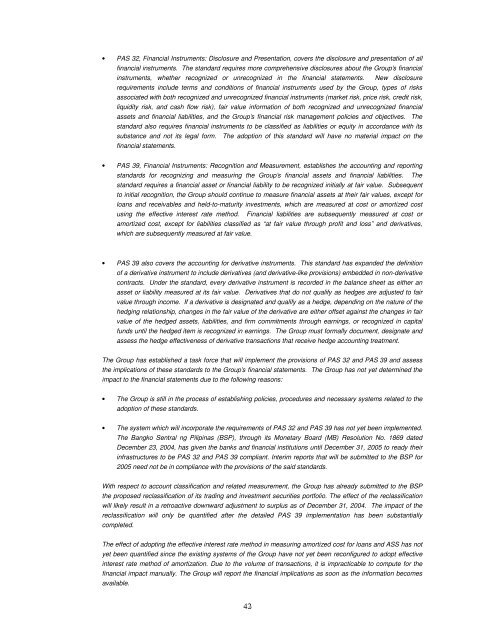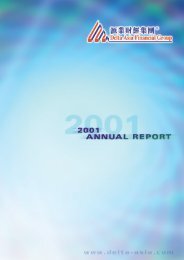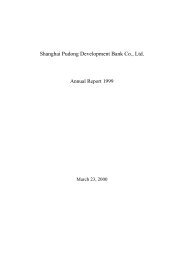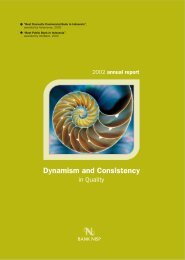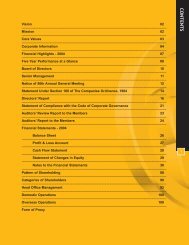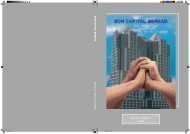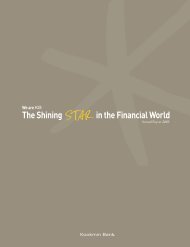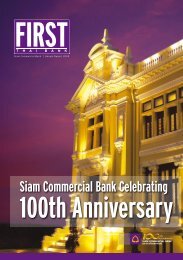2004 - Asianbanks.net
2004 - Asianbanks.net
2004 - Asianbanks.net
- No tags were found...
Create successful ePaper yourself
Turn your PDF publications into a flip-book with our unique Google optimized e-Paper software.
• PAS 32, Financial Instruments: Disclosure and Presentation, covers the disclosure and presentation of allfinancial instruments. The standard requires more comprehensive disclosures about the Group’s financialinstruments, whether recognized or unrecognized in the financial statements. New disclosurerequirements include terms and conditions of financial instruments used by the Group, types of risksassociated with both recognized and unrecognized financial instruments (market risk, price risk, credit risk,liquidity risk, and cash flow risk), fair value information of both recognized and unrecognized financialassets and financial liabilities, and the Group’s financial risk management policies and objectives. Thestandard also requires financial instruments to be classified as liabilities or equity in accordance with itssubstance and not its legal form. The adoption of this standard will have no material impact on thefinancial statements.• PAS 39, Financial Instruments: Recognition and Measurement, establishes the accounting and reportingstandards for recognizing and measuring the Group’s financial assets and financial liabilities. Thestandard requires a financial asset or financial liability to be recognized initially at fair value. Subsequentto initial recognition, the Group should continue to measure financial assets at their fair values, except forloans and receivables and held-to-maturity investments, which are measured at cost or amortized costusing the effective interest rate method. Financial liabilities are subsequently measured at cost oramortized cost, except for liabilities classified as “at fair value through profit and loss” and derivatives,which are subsequently measured at fair value.• PAS 39 also covers the accounting for derivative instruments. This standard has expanded the definitionof a derivative instrument to include derivatives (and derivative-like provisions) embedded in non-derivativecontracts. Under the standard, every derivative instrument is recorded in the balance sheet as either anasset or liability measured at its fair value. Derivatives that do not qualify as hedges are adjusted to fairvalue through income. If a derivative is designated and qualify as a hedge, depending on the nature of thehedging relationship, changes in the fair value of the derivative are either offset against the changes in fairvalue of the hedged assets, liabilities, and firm commitments through earnings, or recognized in capitalfunds until the hedged item is recognized in earnings. The Group must formally document, designate andassess the hedge effectiveness of derivative transactions that receive hedge accounting treatment.The Group has established a task force that will implement the provisions of PAS 32 and PAS 39 and assessthe implications of these standards to the Group’s financial statements. The Group has not yet determined theimpact to the financial statements due to the following reasons:• The Group is still in the process of establishing policies, procedures and necessary systems related to theadoption of these standards.• The system which will incorporate the requirements of PAS 32 and PAS 39 has not yet been implemented.The Bangko Sentral ng Pilipinas (BSP), through its Mo<strong>net</strong>ary Board (MB) Resolution No. 1869 datedDecember 23, <strong>2004</strong>, has given the banks and financial institutions until December 31, 2005 to ready theirinfrastructures to be PAS 32 and PAS 39 compliant. Interim reports that will be submitted to the BSP for2005 need not be in compliance with the provisions of the said standards.With respect to account classification and related measurement, the Group has already submitted to the BSPthe proposed reclassification of its trading and investment securities portfolio. The effect of the reclassificationwill likely result in a retroactive downward adjustment to surplus as of December 31, <strong>2004</strong>. The impact of thereclassification will only be quantified after the detailed PAS 39 implementation has been substantiallycompleted.The effect of adopting the effective interest rate method in measuring amortized cost for loans and ASS has notyet been quantified since the existing systems of the Group have not yet been reconfigured to adopt effectiveinterest rate method of amortization. Due to the volume of transactions, it is impracticable to compute for thefinancial impact manually. The Group will report the financial implications as soon as the information becomesavailable.- 42-


